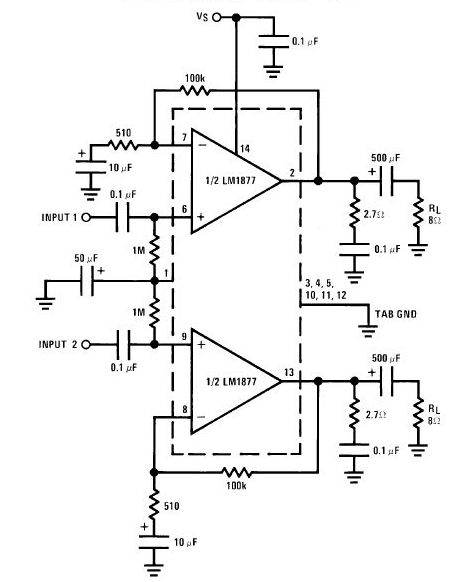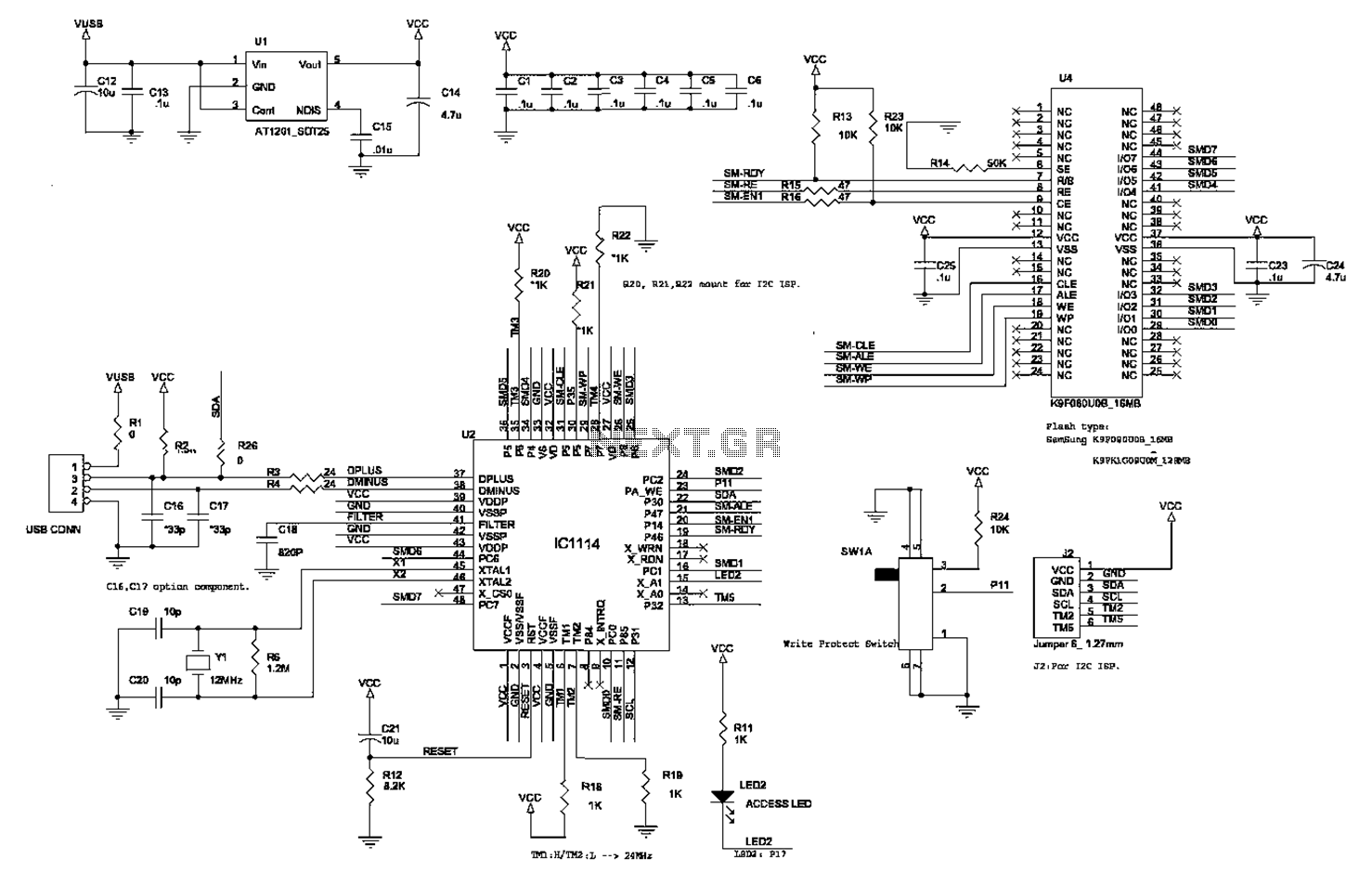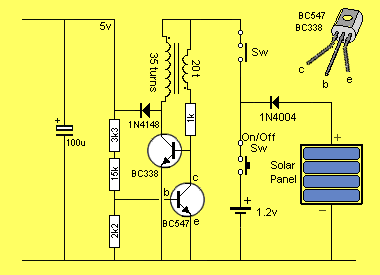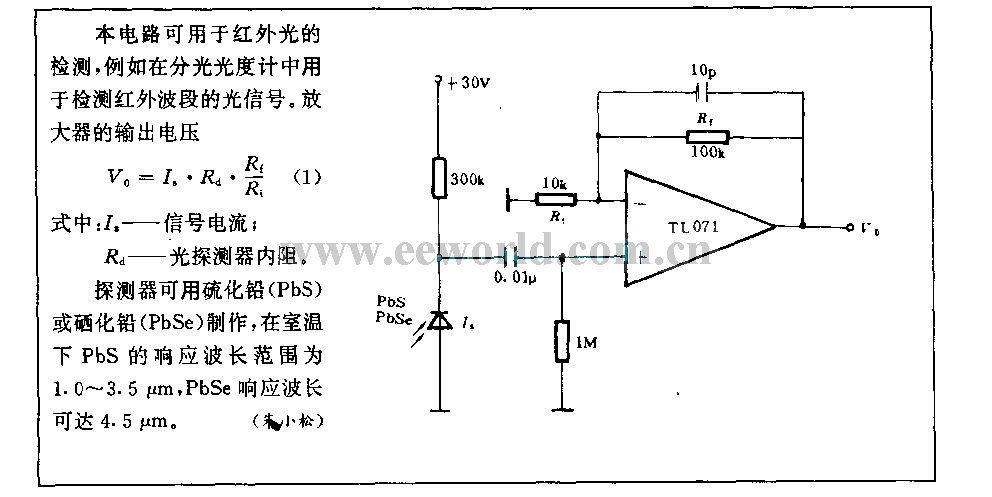
Homemade wireless remote control circuit diagram
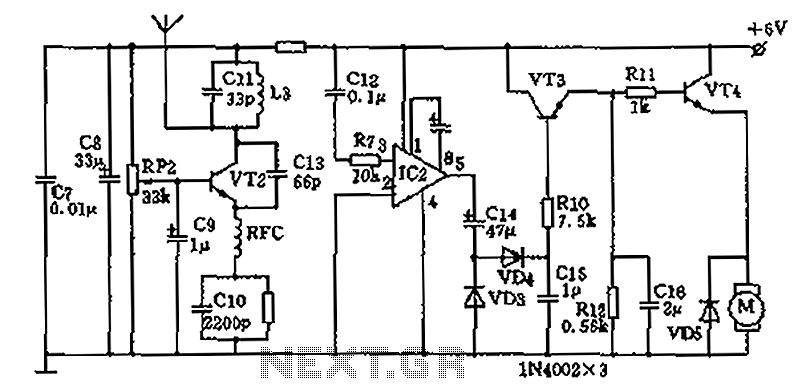
The homemade wireless remote control circuit diagram illustrates a motor remote control transmitter circuit. The circuit utilizes a 555 timer along with resistors R1, R2, RP1, diodes VD1, VD2, and capacitor C1 to create a variable duty cycle astable oscillator. The oscillation frequency is approximately 50Hz, adjustable by changing the resistance of RP1, allowing the duty cycle to range from 1% to 99%, with a square wave output at 50Hz. Transistor VT1 and additional components form a crystal frequency stabilization circuit with a resonant frequency of 27.145MHz. This stabilization ensures reliability. The modulated square wave signal generated by the 555 oscillation circuit is transmitted via a high-frequency carrier signal emitted from the antenna. Component selection includes a 10K L1 type skeleton inductor made with 0.15mm high-strength enameled wire wound in 9 turns, with L2 constructed similarly but with 3 turns and no shielding, requiring a screwed core. L3 is produced from L1. The resonator frequency for the metal shell is between 27-29.8MHz. Transistors VT1, VT2, and VT3 are 3DG130D NPN types, while VT4 is a 3DD15D power transistor. The RFC inductor has a value of 18uH. IC1 is an NE555 timer, and IC2 is an LM386. Unless otherwise specified, electrolytic capacitors are used, with high-frequency ceramic capacitors employed for CC1. Resistors are 1/8W carbon film types.
For circuit debugging, it is essential to focus on the transmitter carrier frequency oscillator. Temporarily install the high-frequency choke coil B and RFC while shorting C4 to ground. Adjust R3 to ensure the collector current of VT1 reaches 12mA. After installing crystal B, the current should rise to about 15mA; adjust the core of L1 carefully until the circuit starts, then remove the short from C4. The super-regenerative detector can be debugged using high-impedance headphones (800 series) connected with a 10uF capacitor across the emitter and collector of VT2. Fine-tune the coil L3 and its core with potentiometer RP2 until a noticeable rustling sound is heard through the headset. Bring the transmitter antenna close to the receiver and turn on the control switch S, then fine-tune the transmitter and receiver coil core until the headset clearly hears the frequency sound stop. After separating the two devices, further fine-tuning may be necessary. The remaining parts of the circuit generally do not require additional debugging and can be installed as is. As shown in FIG homemade wireless remote control circuit diagram; A motor remote road works Wireless remote control transmitter circuit As shown for the remote control transmit ter. Manifold 555 and R1, R2, RP1, VD1, VD2 and C1 form a wide range of variable duty cycle astable oscillator. Oscillation frequency parameter is shown around 50Hz, by adjusting the resistance RP1, vary the duty cycle of up to 1% to 99%, by the pin output 50Hz square wave signal.
VT1 and external components, crystal frequency stabilization capacitance three-point oscillator, the resonant frequency of the quartz crystal selection 27.145MHz. The quartz crystal frequency stabilization circuit, so reliable. VT1 modulated square wave signal generated by the oscillation circuit 555 via the high-frequency carrier feet from the antenna out.
Second, the choice of components Available 10K L1 type skeleton in the week, with µ0.15 high strength enameled wire around 9 turns, L2 with the same model in the outer wire 3 turns of L1, without shield, but need screwed core. L3 with L1 production. B with JAl2 other metal shell resonator frequency between 27-29.8MHz. VT1, VT2, VT3 are made 3DG130D type NPN transistor, 100. VT4 selection 3DD15D-power tube. RFC by 18uH inductors color code. IC1 model for NE555. IC2 model for the LM386. Unless otherwise specified capacitance electrolytic capacitors are used outside the high-frequency ceramic capacitors CC1.
Resistors are made of 1/8w carbon film resistors. Third, debugging circuit To emphasize the transmitter carrier frequency oscillator, high-frequency choke coil B crystal and RFC temporarily installed, make C4 a short to ground. Adjust R3 resistance, so that VT1 collector current of 12mA, then install the crystal B, this time the current will increase to about 15mA, or should be carefully adjusted core L1 until the start-up circuit, remove C4 short route.
Super-regenerative detector debugging method is to use a high-impedance headphones 800 series with a 10uF capacitor connected across the emitter and collector VT2, with no sense of screwdriver potentiometer RP2 fine tuning coil L3 and core, until the headset in obviously resounding rustling sound. Next to the transmitter antenna near the receiver, turn pass control switch S, to fine-tune the transmitter and the receiver coil core, until the headset can be heard clearly frequency sound stops, then pull away from the two planes, and then further fine-tuning.
Rest of the circuit without debugging, you can work generally installed after.
For circuit debugging, it is essential to focus on the transmitter carrier frequency oscillator. Temporarily install the high-frequency choke coil B and RFC while shorting C4 to ground. Adjust R3 to ensure the collector current of VT1 reaches 12mA. After installing crystal B, the current should rise to about 15mA; adjust the core of L1 carefully until the circuit starts, then remove the short from C4. The super-regenerative detector can be debugged using high-impedance headphones (800 series) connected with a 10uF capacitor across the emitter and collector of VT2. Fine-tune the coil L3 and its core with potentiometer RP2 until a noticeable rustling sound is heard through the headset. Bring the transmitter antenna close to the receiver and turn on the control switch S, then fine-tune the transmitter and receiver coil core until the headset clearly hears the frequency sound stop. After separating the two devices, further fine-tuning may be necessary. The remaining parts of the circuit generally do not require additional debugging and can be installed as is. As shown in FIG homemade wireless remote control circuit diagram; A motor remote road works Wireless remote control transmitter circuit As shown for the remote control transmit ter. Manifold 555 and R1, R2, RP1, VD1, VD2 and C1 form a wide range of variable duty cycle astable oscillator. Oscillation frequency parameter is shown around 50Hz, by adjusting the resistance RP1, vary the duty cycle of up to 1% to 99%, by the pin output 50Hz square wave signal.
VT1 and external components, crystal frequency stabilization capacitance three-point oscillator, the resonant frequency of the quartz crystal selection 27.145MHz. The quartz crystal frequency stabilization circuit, so reliable. VT1 modulated square wave signal generated by the oscillation circuit 555 via the high-frequency carrier feet from the antenna out.
Second, the choice of components Available 10K L1 type skeleton in the week, with µ0.15 high strength enameled wire around 9 turns, L2 with the same model in the outer wire 3 turns of L1, without shield, but need screwed core. L3 with L1 production. B with JAl2 other metal shell resonator frequency between 27-29.8MHz. VT1, VT2, VT3 are made 3DG130D type NPN transistor, 100. VT4 selection 3DD15D-power tube. RFC by 18uH inductors color code. IC1 model for NE555. IC2 model for the LM386. Unless otherwise specified capacitance electrolytic capacitors are used outside the high-frequency ceramic capacitors CC1.
Resistors are made of 1/8w carbon film resistors. Third, debugging circuit To emphasize the transmitter carrier frequency oscillator, high-frequency choke coil B crystal and RFC temporarily installed, make C4 a short to ground. Adjust R3 resistance, so that VT1 collector current of 12mA, then install the crystal B, this time the current will increase to about 15mA, or should be carefully adjusted core L1 until the start-up circuit, remove C4 short route.
Super-regenerative detector debugging method is to use a high-impedance headphones 800 series with a 10uF capacitor connected across the emitter and collector VT2, with no sense of screwdriver potentiometer RP2 fine tuning coil L3 and core, until the headset in obviously resounding rustling sound. Next to the transmitter antenna near the receiver, turn pass control switch S, to fine-tune the transmitter and the receiver coil core, until the headset can be heard clearly frequency sound stops, then pull away from the two planes, and then further fine-tuning.
Rest of the circuit without debugging, you can work generally installed after.
Warning: include(partials/cookie-banner.php): Failed to open stream: Permission denied in /var/www/html/nextgr/view-circuit.php on line 713
Warning: include(): Failed opening 'partials/cookie-banner.php' for inclusion (include_path='.:/usr/share/php') in /var/www/html/nextgr/view-circuit.php on line 713

